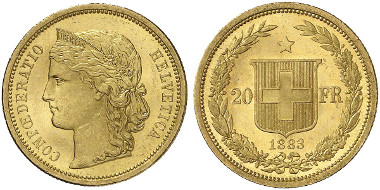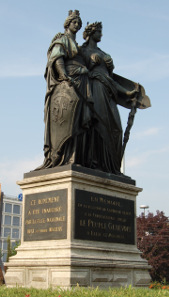courtesy of the MoneyMuseum, Zurich
translated by Teresa Teklic
Why was the human head the motif on coins for centuries, no, for millennia? And why did that change in the last 200 years? Ursula Kampmann is looking for answers to these questions in her book “MenschenGesichter” (“Human faces”), from which the texts in this series are taken.
Swiss Confederation. 20 francs, 1883, Bern. Personified Helvetia with diadem and Alpine rose wreath facing left. R. Swiss coat of arms in a laurel and oak wreath. © MoneyMuseum, Zurich.
If you look at a Swiss circulation coin today, you can see straight into the 19th century: The same motifs have been used here for far more than 100 years.
The obverse of the first gold coin minted for circulation in modern Switzerland, issued in 1883, did not differ noticeably from the 5-, 10-, or 20-rappen pieces introduced in 1879 and 1881 that are still used today. What seems somewhat old-fashioned to us today was a highly fashionable, state-of-the-art self-portrait at the time.
Helvetia is taking Geneva under her wings. Memorial to the accession of Geneva to the Swiss Confederation in 1814, inaugurated in 1869. Photo: Norbert Aepli – CC-BY-2.5.
Helvetia, after all, did not only make an appearance as a coin motif: Every parade, every festive celebration was dotted with young women who exhibited themselves as personifications of Switzerland, their cantons, or their cities. The following story is one instance of many, in which Helvetia presents herself directly to us. Events such as this turned Helvetia into a very real and tangible motif.
In 1892, a big celebration was held to commemorate the 500th anniversary of the unification of Basel and lesser Basel. The ceremonies climaxed in a gigantic theatre performance, written by Rudolf Wackernagel, a hobby poet who is otherwise completely unknown, and for good reason. Basel’s history was brought to the audience in the form of different historical scenes. After the last tableau, all performers came together on stage. They provided the colourful background for the entry of Basilea, the personification of Basel, and Helvetia. The young women had been chosen for these roles because their fathers held important political offices. They were wearing long robes decorated with their respective arms. Basilea was further balancing a mural crown on her head, Helvetia a diadem. It is the diadem that we find on this coin motif. It bears the inscription “LIBERTAS” (Liberty), a visualisation of the statement that Switzerland is crowned by liberty.
Enter Clio, the muse of history. She tells the story of how Basel joined the Confederation. Replies Basilea: Nothing but liberty itself had moved her to accept Switzerland’s maternal embrace in order to maintain precisely this liberty as an eternal gift of the mother. Now Helvetia expresses her maternal feelings for Basilea and all those longing for freedom with much pathos in her words. The two embrace and for the finale the audience joins in when all performers sing the Swiss national anthem, which, at the time, was “When you call, my Fatherland”.
How Helvetia became “Vreneli” will be the subject of the next episode.
You can find all episodes in the series here.
A German edition of the book “MenschenGesichter” is available in print and as ebook on the site of the Conzett Verlag.





